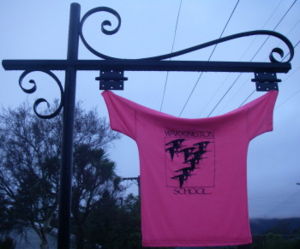Warrington School/Curriculum
Contents
Goal
To create a curriculum that reflects our charter goals and meets the needs of our Warrington community
Curriculum Components
- Pedagogy has long been a neglected area in most countries. In recent years the emphasis has been on a technocratic curriculum for teachers to follow and to be held accountable to. New evidence suggests that it is the quality of the individual teachers that makes the greatest difference to ensure students learn. It seems the "experts" have been looking in the wrong place for answers during past decades, overlooking in the process successful ideas of creative teachers in the schools.
Education Today Issue 3, 2008 Term 2
We recognise that the below pedagogies and strategies are not mutually exclusive, and that some combination of them was likely to prove most effective
Progressive Education
Attending to the whole child - is concerned with helping children become good learners and people
- Schooling is seen as holistic
Community - children learn with and from one another in a caring community, and that’s true of moral as well as academic learning
- Interdependence counts at least as much as independence
Collaboration - progressive schools are characterized by a “working with” model
- An emphasis on collaborative problem-solving and on underlying motives, values, and reasons
Social justice - a sense of community and responsibility for others
- Students are helped to locate themselves in widening circles of care that extend beyond self, beyond friends, beyond their own ethnic group, and beyond their own country
- Opportunities are offered to learn about, to put into action, a commitment to diversity and to improving the lives of others
Intrinsic motivation - the effect on students’ interest in learning, their desire to continue reading, thinking, and questioning is considered when setting educational policies and practices
- Conventional practices, including homework, grades, and tests, prove difficult to justify when serious about promoting long-term dispositions
Deep understanding - facts and skills do matter, but only in a context and for a purpose
- Progressive education tends to be organized around problems, projects, and questions
- Typically interdisciplinary, the assessment rarely focuses on rote memorization
- The point is to invite pupils to think deeply about issues that matter and help them understand ideas from the inside out
Active learning - in progressive schools, students play a vital role in helping to design the curriculum
- They formulate the questions, seek out (and create) answers, think through possibilities, and evaluate how successful they — and their teachers — have been
- The pupils participation in the process is consistent with learning being a matter of constructing ideas
Taking kids seriously - taking a cue from the students and being attentive to differences among them
- Each student is unique, so a single set of policies, expectations, or assignments would be counterproductive)
- Teachers will have broadly conceived themes and objectives, design the curriculum with the pupils and welcome unexpected detours
- One teacher’s curriculum, won’t be the same as that of the teacher next door, nor will her curriculum be the same this year as it was for the children she taught last year
- Progressive education students help to formulate not only the course of study but also the outcomes or standards that inform those lessons
So what is intelligence anyway?
NZ Curriculum Objectives
English
- English Levels 1-4
- Writing - Explanation Criteria
- Essential Spelling List
- Upper Primary - writing tools checklist

- Reading Responses for Years 4-8
- Guidelines for Reading Books
Mathematic
The Arts
- The Arts Levels 1-4
- The Arts Curriculum Levels 1-4
- Dance Curriculum Levels 1-4
- Visual Arts Curriculum Levels 1-4
- Drama Curriculum Levels 1-4
- Music Curriculum Levels 1-4
Science
Social Science
Warrington School's Local Curriculum Goals
- Maths
- Maori
- Social Sciences
- English
- ICT
- Technology
- Science
- The Arts
- Health and PE
- EOTC
- Envirethical Education
- Spelling Programme
- Warrington 2 Year Curriculum Plan
- Autistic Students
- Key Competencies
Assessment - NAG 1c
Informative Video
- Use assessment information to identify pupils and groups of pupils:
- Who are not achieving
- Who are at risk of not achieving
- Who have special needs1
- And aspects of the curriculum which require particular attention
- Pupils will be assesed by a variety of tools - formative, summative, moderating, self and peer
- Pupils falling into the low or high attainment categories will be identified and placed onto the Face to Face list
- Teachers in consultation with their colleagues will make professional judgements in what they need to do next to assist identified pupils – if anything
- Parents of these identified pupils will be notified via a verbal or written report
- The Board may be requested to fund further assistance or support on an individual or group basis
- Specialist assistance may be sought through our SENCO
Pupil Assessment Data
- Teachers will record the data of each pupil into a document that can be shared with:
- Other staff
- Pupils and their parents
- It will contain a summarised marking scale for expected level for pupil:
- 1=above average, 2=average, 3=below average, 4=well below average
- Cells may show start and end year of year results
- Teachers will retain original data in their own records
- Numbers in range will indicate - pupils with:
- 4s = Face to Face programme
- 3s = possible Face to Face programme
- 1s = will be referred to school's SENCO to see if their needs are being met
Converting scores/stanines to the above stanine 9,8 = above, 7,6,5 = at, 4,3 below and 2,1 well below Converting this to scores out of 100 = 90, 80 = above, 70,60,50 = at, 40,30 = below and 20,10 = well below
- Pupil Profile
- Warrington School/National Standards
- Warrington School/Pupil Reports
- PAT Maths Analysis 2010
- School Wide Asssessment Schedule
- Warrington School/Venn Diagram Checklist
- Basic Facts Checklist Years 5-8

- Basic Facts Checklist Years 3-4

- Spellwrite Essential List 1-4 Answer Sheet

- Report Checklist

School Systems
- Warrington School/Responsibilities
- Warrington School/Relievers
- Face to face teaching
- Hi-viz Vests
- Circle Time
Teaching and learning plans
- Room 2 Planning
- Room 3 Planning
- Term 3 Planning 2011
- Warrington School/Planning 2008
- Warrington School/Term One Planning 2009
- Warrington School/Term Two Planning 2009
- Warrington School/Term Three Planning 2009
- Warrington School/Eco Hut/Garden Planning 2009
- Warrington School/Term Four Planning 2009
- Warrington School/Pupil Goals
- Term One Planning 2010
- Term Two Planning 2010
- Term Three Planning 2010
- Term Four Planning 2010
- Term One Planning 2011
- Term Two Planning 2011
- Inquiry Process
- 6 Thinking Hats
- Other Educational Philosophy Components
- Bloom's Taxonomy
- John Taylor Gatto
- Left/Right Brain
- Learning Styles
- Learning Styles and Multiple Intelligences
- Art Costa's 16 Habits of Mind
- Dr Edward de Bono and the Six Thinking Hats
Learning Sequence
Sequential, linear versus random, spontaneous. Needing further contributions.


